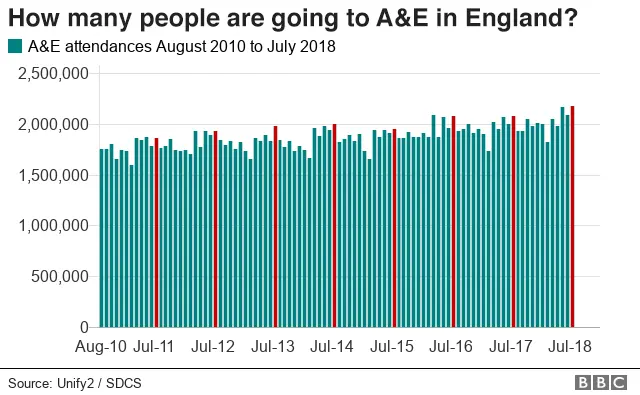Heatwave blamed for record A&E attendances in England
 Getty Images
Getty ImagesThe heatwave is being blamed for record numbers of people going to A&E in England in July.
As temperatures soared, attendances reached more than 2.1 million - the highest since records began in 2010.
The number of patients waiting more than a year for non-urgent surgery also rose to their highest point in more than six years, at 3,517.
This is despite a pledge in 2014 by the then Health Secretary Jeremy Hunt to end the "unacceptable" waits.
The figures are part of a raft of data released on Thursday by NHS England.
'Severe strain'
Health bodies said the heatwave had added to existing pressures on the NHS, with reports of more people turning up with dehydration, heart failure and kidney problems related to the unusually high temperatures.
Prof John Appleby, chief economist of the Nuffield Trust health think tank, said: "July 2018 was the most pressured summer month for A&E departments in recent history, showing that there's no doubt this summer's heatwave has caused severe strain on the NHS."
A&E attendances reached 2,176,022 in July - up from 2,091,318 in June - although attendances have steadily climbed since 2010.

The NHS England data also shows there were 530,000 emergency admissions to A&E, a figure only surpassed once - in May this year - since 2010.
The number of patients waiting more than the target time of 18 weeks for routine surgery in June was also at the highest level in a decade, at more than 500,000.
The NHS is meant to see 90% of patients who need such operations within 18 weeks, but only 87.8% of patients were seen in that time.
'Summer surge'
The Society for Acute Medicine said the summer was usually a time for frontline staff to "recharge the batteries" but that had not happened this year.
Dr Nick Scriven, the society's president, said: "Last year NHS leaders admitted it took until October to recover from winter 2017 and we are now only a few months away from the next onslaught...
"On the plus side, this may have triggered alarm bells earlier than normal and lead to some positive actions being put in place to help us contend with the inevitable winter pressures we will face."
The Royal College of Nursing said the heatwave had placed winter-like strains on the health service.
Donna Kinnair, director of nursing policy and practice at the RCN, said nurses were seeing more cases of heart failure, renal failure and dehydration, with older people being particularly at risk.
An NHS England spokesman added that there had been an "unprecedented summer surge" in July.
"Thanks to the hard work of staff, nine in 10 people were seen, treated and admitted or discharged within four hours," the spokesman said.

GP satisfaction
Separately, a survey of 760,000 people across England on their views of their GP practices showed nearly 40% of patients were unable to get an appointment at the time they wanted.
It also found that just 66% of patients who wanted a same-day appointment said they managed to get one.
However, nearly 84% described their overall experience of their surgery as very or fairly good.
And 68.6% rated their overall experience of making an appointment as good.
 Getty Images
Getty ImagesAbout a third (35.6%) of patients who wanted to see a GP but found their practice was closed said they ended up going to A&E.
The survey of patients in England has been redesigned and now includes 16 to 17-year-olds for the first time, so results cannot be compared to previous years, NHS England said.

Children with eating disorders
NHS England also released data on waiting times for young people being treated for eating disorders.
In 2016 it introduced waiting time targets to ensure fast treatment for under-19s with eating disorders, such as anorexia and bulimia.
NHS England's figures showed that the proportion of routine cases being seen within the four-week target has risen from 79.9% to 81.2% on the previous quarter.
That means 1,243 children and young people out of a total of 1,530 were seen within the target.
But the number of urgent cases seen within the target of one week fell from 78.9% to 74.7% - equivalent to 219 young people out of a total of 293.
Andrew Radford, chief executive of Beat, the eating disorder charity, said there was still a postcode lottery on how long children and young people were waiting for treatment.
An NHS England spokesman said there had been a significant improvement in treatment times for NHS care.
"An extra £30m is going into children's eating disorder services every year, with 70 new and improved treatment centres set up in 2017, covering the whole of the country to ensure more young people get the right care, at the time, closer to home," he said.
